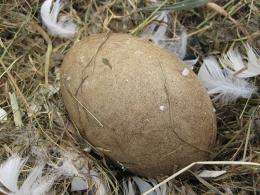July 30, 2014 report
Study finds color and thickness of eggshells in wild birds related to light level exposure

A team of biology researchers with members from Australia, the U.S., Czech Republic and the U.K. has found a correlation between eggshell color and thickness and the amount of light that shines on the eggs during incubation. In their paper published in Functional Ecology, the team describes their study that involved the analysis of eggshells from many native bird species in Britain and the results they found in doing so.
Different bird species lay their eggs in different places—most everyone knows that—some birds lay their eggs in nests in trees, others on the ground, while still others lay them in nests hidden from view inside of holes, etc. Wild bird eggs also come in a wide variety of colors and some have markings that serve as camouflage. Less well known is that shell thickness varies between species and previous research has found that some pigments in shells help fight embryo infections. In this new study, the researchers set out to determine if shell color and thickness might be related to how much sunlight exposure the eggs get. To find out, they analyzed eggshells residing in various museums—measuring thickness, pigment concentration, permeability, and their surface reflectance spectrum (color)—in all eggshells from 74 different species were examined. Most specifically, they focused on measuring how much light could come through a particular shell using a spectrophotometer. Once the examinations were complete, the researchers related what they'd learned about the eggshells to the environment in which the eggs were incubated and that led to correlations between color and sunlight exposure.
The team found that eggs exposed to a lot of sunlight, such as those nested on the ground, had more pigment than did those that were hidden away, such as those tucked in tree holes or concealed in burrows. Eggs from hidden nests were the ones that were pure white, allowing the most light to penetrate the shell. The team also found that species with longer incubation periods tended to also have more color and thicker shells.
The researchers conclude that eggshell thickness and color are a form of sunscreen, allowing in just the right amount of UV radiation—if there is too little light the babies inside won't develop properly—if there's too much, damage would result.
More information: Functional Ecology, 29 JUL 2014. DOI: 10.1111/1365-2435.12314
Journal information: Functional Ecology
© 2014 Phys.org



















